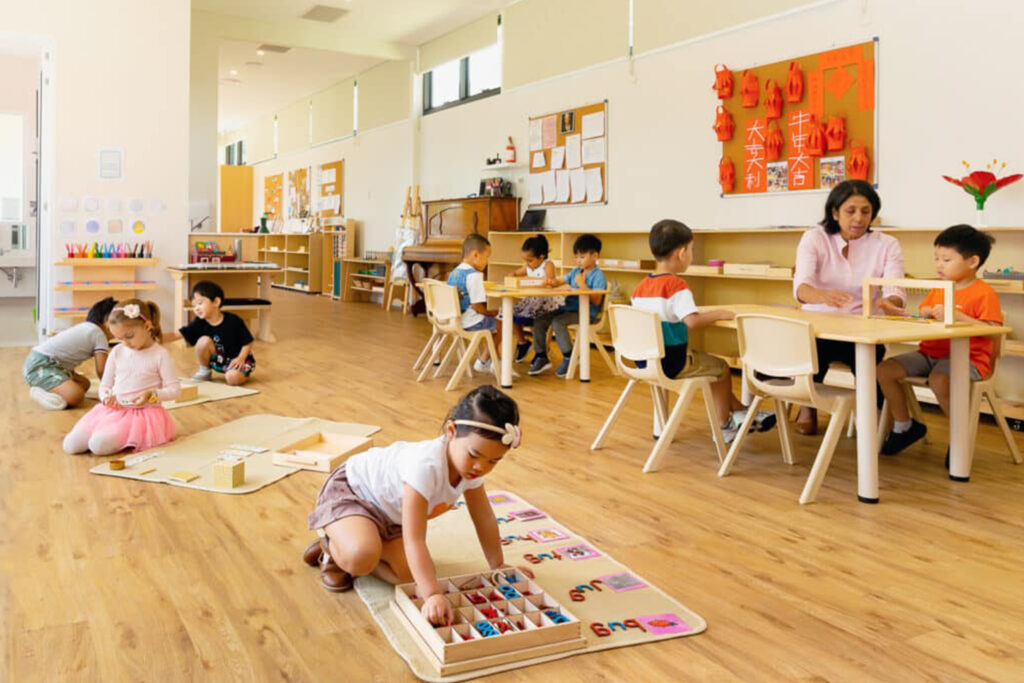Montessori educators view children as naturally eager and capable of initiating and pursuing learning, guided by their own interests. To support children as they learn, Montessori schools provide thoughtfully prepared, age-appropriate environments that nurture children’s cognitive, social, emotional, and physical development.
Regardless of the type of Montessori school—for example, independent, private, or public/charter; secular or faith-based—the American Montessori Society recognizes 5 components as critical to high-fidelity implementation of the Montessori Method.
1. TRAINED MONTESSORI TEACHERS
A properly credentialed Montessori teacher has the skills and expertise to implement high-fidelity Montessori.
2. THE MULTI-AGE CLASSROOM
Classes with 3-year age spans facilitate mentorship among the students and encourage leadership development.
3. USING MONTESSORI MATERIALS
A hallmark of Montessori is specially designed materials that provide a hands-on approach to learning.
4. CHILD-DIRECTED WORK
Students are given agency to self-select work, leading to intrinsic motivation and sustained attention.
4. UNINTERRUPTED WORK PERIODS
An extended period of “free choice” enables students to work at their own pace and without interruption.
Trained Montessori Teachers
A properly credentialed Montessori teacher understands the importance of enabling children to develop naturally. The teacher observes children within a specific age range and introduces them to challenging and developmentally appropriate lessons and materials based on observations of each child’s unique interests, abilities, and social, emotional, cognitive, and physical development.
A trained Montessori teacher is well versed not only in Montessori theory and philosophy, but also in the accurate and appropriate use of Montessori materials. She has observational skills to guide and challenge her students, a firm foundation in human growth and development, and the leadership skills necessary for fostering a nurturing environment that physically and psychologically supports learning.
To acquire these unique skills, it is essential that Montessori teachers receive training in the age level at which they teach. AMS recognizes Montessori teaching credentials issued by AMS, the Association Montessori Internationale (AMI), or by any other Montessori teacher education programs that are accredited by the Montessori Accreditation Council for Teacher Education (MACTE).
The Multi-Age Classroom
In Montessori schools, multi-age groupings enable younger children to learn from older children and experience new challenges through observation. Older children reinforce their own learning by teaching concepts they have already mastered, while developing leadership skills and serving as role models. Because each student’s work is individual, children progress at their own pace; there is cooperation rather than competition between the ages. This arrangement mirrors the real world, in which individuals work and socialize with people of all ages and dispositions.
In a Montessori classroom, students work together in mixed-age groupings specific to the developmental stages for which Montessori education is based. Though some schools may alter these age groupings for reasons such as state regulations, best practices in Montessori follows these age groupings:
- Infants: Within a range of birth – 18 months
- Toddlers: Within a range of 15 months – 3 years
- Early Childhood: Ages 2½ – 6
- Lower Elementary: Ages 6 – 9
- Upper Elementary: Ages 9 – 12 (or a combined Lower and Upper Elementary, ages 6 – 12)
- Secondary: Ages 12 – 15 and 15 – 18, or 12 – 14, 14 – 16, and 16 – 18
Using Montessori Materials
A hallmark of Montessori education is the hands-on approach to learning and the use of specially designed learning materials. Beautifully and precisely crafted, Montessori’s distinctive learning materials each teach a single skill or concept. The materials follow a logical, developmentally appropriate progression that allows the child to develop an abstract understanding of a concept.
Child-Directed Work
Montessori education supports children in choosing meaningful and challenging work that captures their interest, leading to engagement, intrinsic motivation, sustained attention, and a sense of responsibility to oneself and others. This child-directed work is supported by the design and flow of the Montessori classroom, which is created to ignite each child’s curiosity and to provide the opportunity to work in calm, uncluttered spaces either individually or with peers.
In a Montessori classroom, children are free to move around and explore—in fact, Dr. Maria Montessori, the founder of the movement more than a century ago, designed her classrooms with that in mind. Teachers guide children and keep them on the path to learning, and ensure that the classroom environment is respectful, orderly, and productive.
Uninterrupted Work Periods
In Montessori classrooms, an extended period of “free choice” time called the “uninterrupted work period” recognizes and respects individual variations in the learning process. During the work period, students have time to select and work through various tasks and responsibilities at their own pace, without interruption.
A child’s work cycle involves selecting an activity, performing the activity for as long as they are interested in it, cleaning up the activity and returning it to the shelf, then selecting another activity. During the work period, teachers support and monitor the students’ work and provide individual and small-group lessons. The uninterrupted work period facilitates the development of coordination, concentration, and independence.
For each of the Montessori program levels, AMS recommends the following periods of uninterrupted work:
- Infant & Toddler: At minimum, a daily 2-hour work cycle. The time block allows for adult-assisted mealtime, snacks, hygiene, and nap/rest routines.
- Early Childhood: At minimum, a 2-hour work cycle, 4 days per week. A 3-hour uninterrupted work cycle, 5 days per week is optimal.
- Elementary: At minimum, a 2-hour work cycle, 4 days per week. A 3-hour uninterrupted work cycle, 5 days per week is optimal.
- Secondary: At minimum, a 2-hour work cycle for core curricular subjects (math, English, history or humanities, sciences, and additional world languages).


